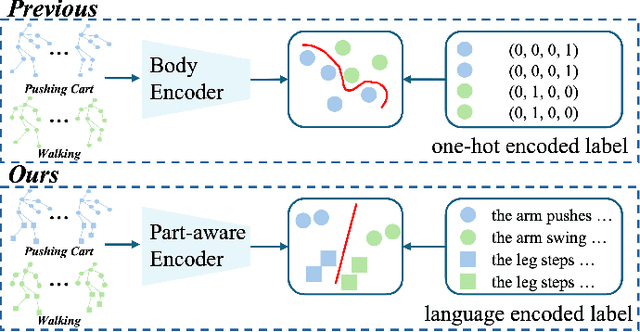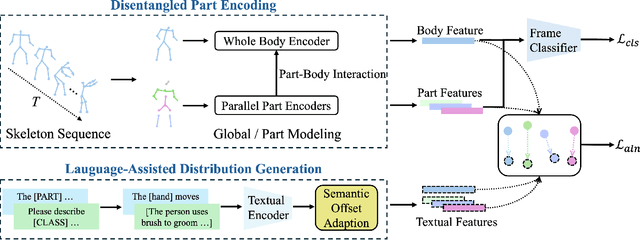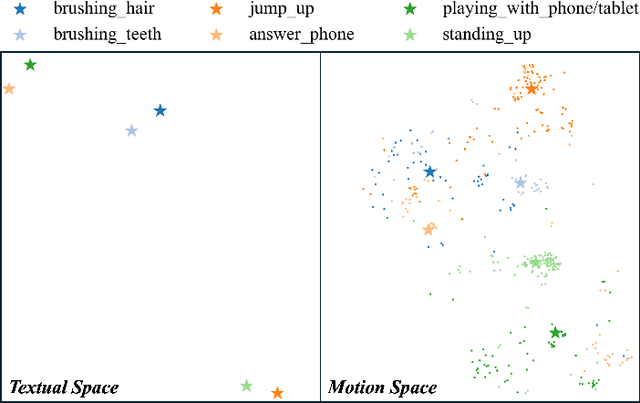Benjamin Filtjens
GAITGen: Disentangled Motion-Pathology Impaired Gait Generative Model -- Bringing Motion Generation to the Clinical Domain
Mar 28, 2025Abstract:Gait analysis is crucial for the diagnosis and monitoring of movement disorders like Parkinson's Disease. While computer vision models have shown potential for objectively evaluating parkinsonian gait, their effectiveness is limited by scarce clinical datasets and the challenge of collecting large and well-labelled data, impacting model accuracy and risk of bias. To address these gaps, we propose GAITGen, a novel framework that generates realistic gait sequences conditioned on specified pathology severity levels. GAITGen employs a Conditional Residual Vector Quantized Variational Autoencoder to learn disentangled representations of motion dynamics and pathology-specific factors, coupled with Mask and Residual Transformers for conditioned sequence generation. GAITGen generates realistic, diverse gait sequences across severity levels, enriching datasets and enabling large-scale model training in parkinsonian gait analysis. Experiments on our new PD-GaM (real) dataset demonstrate that GAITGen outperforms adapted state-of-the-art models in both reconstruction fidelity and generation quality, accurately capturing critical pathology-specific gait features. A clinical user study confirms the realism and clinical relevance of our generated sequences. Moreover, incorporating GAITGen-generated data into downstream tasks improves parkinsonian gait severity estimation, highlighting its potential for advancing clinical gait analysis.
Language-Assisted Human Part Motion Learning for Skeleton-Based Temporal Action Segmentation
Oct 08, 2024



Abstract:Skeleton-based Temporal Action Segmentation involves the dense action classification of variable-length skeleton sequences. Current approaches primarily apply graph-based networks to extract framewise, whole-body-level motion representations, and use one-hot encoded labels for model optimization. However, whole-body motion representations do not capture fine-grained part-level motion representations and the one-hot encoded labels neglect the intrinsic semantic relationships within the language-based action definitions. To address these limitations, we propose a novel method named Language-assisted Human Part Motion Representation Learning (LPL), which contains a Disentangled Part Motion Encoder (DPE) to extract dual-level (i.e., part and whole-body) motion representations and a Language-assisted Distribution Alignment (LDA) strategy for optimizing spatial relations within representations. Specifically, after part-aware skeleton encoding via DPE, LDA generates dual-level action descriptions to construct a textual embedding space with the help of a large-scale language model. Then, LDA motivates the alignment of the embedding space between text descriptions and motions. This alignment allows LDA not only to enhance intra-class compactness but also to transfer the language-encoded semantic correlations among actions to skeleton-based motion learning. Moreover, we propose a simple yet efficient Semantic Offset Adapter to smooth the cross-domain misalignment. Our experiments indicate that LPL achieves state-of-the-art performance across various datasets (e.g., +4.4\% Accuracy, +5.6\% F1 on the PKU-MMD dataset). Moreover, LDA is compatible with existing methods and improves their performance (e.g., +4.8\% Accuracy, +4.3\% F1 on the LARa dataset) without additional inference costs.
Skeleton-Based Action Segmentation with Multi-Stage Spatial-Temporal Graph Convolutional Neural Networks
Feb 03, 2022



Abstract:The ability to identify and temporally segment fine-grained actions in motion capture sequences is crucial for applications in human movement analysis. Motion capture is typically performed with optical or inertial measurement systems, which encode human movement as a time series of human joint locations and orientations or their higher-order representations. State-of-the-art action segmentation approaches use multiple stages of temporal convolutions. The main idea is to generate an initial prediction with several layers of temporal convolutions and refine these predictions over multiple stages, also with temporal convolutions. Although these approaches capture long-term temporal patterns, the initial predictions do not adequately consider the spatial hierarchy among the human joints. To address this limitation, we present multi-stage spatial-temporal graph convolutional neural networks (MS-GCN). Our framework decouples the architecture of the initial prediction generation stage from the refinement stages. Specifically, we replace the initial stage of temporal convolutions with spatial-temporal graph convolutions, which better exploit the spatial configuration of the joints and their temporal dynamics. Our framework was compared to four strong baselines on five tasks. Experimental results demonstrate that our framework achieves state-of-the-art performance.
Automated freezing of gait assessment with marker-based motion capture and multi-stage graph convolutional neural networks approaches expert-level detection
Apr 07, 2021



Abstract:Freezing of gait (FOG) is a common and debilitating gait impairment in Parkinson's disease. Further insight in this phenomenon is hampered by the difficulty to objectively assess FOG. To meet this clinical need, this paper proposes a motion capture-based FOG assessment method driven by a novel deep neural network. The proposed network, termed multi-stage graph convolutional network (MS-GCN), combines the spatial-temporal graph convolutional network (ST-GCN) and the multi-stage temporal convolutional network (MS-TCN). The ST-GCN captures the hierarchical motion among the optical markers inherent to motion capture, while the multi-stage component reduces over-segmentation errors by refining the predictions over multiple stages. The proposed model was validated on a dataset of fourteen freezers, fourteen non-freezers, and fourteen healthy control subjects. The experiments indicate that the proposed model outperforms state-of-the-art baselines. An in-depth quantitative and qualitative analysis demonstrates that the proposed model is able to achieve clinician-like FOG assessment. The proposed MS-GCN can provide an automated and objective alternative to labor-intensive clinician-based FOG assessment.
 Add to Chrome
Add to Chrome Add to Firefox
Add to Firefox Add to Edge
Add to Edge